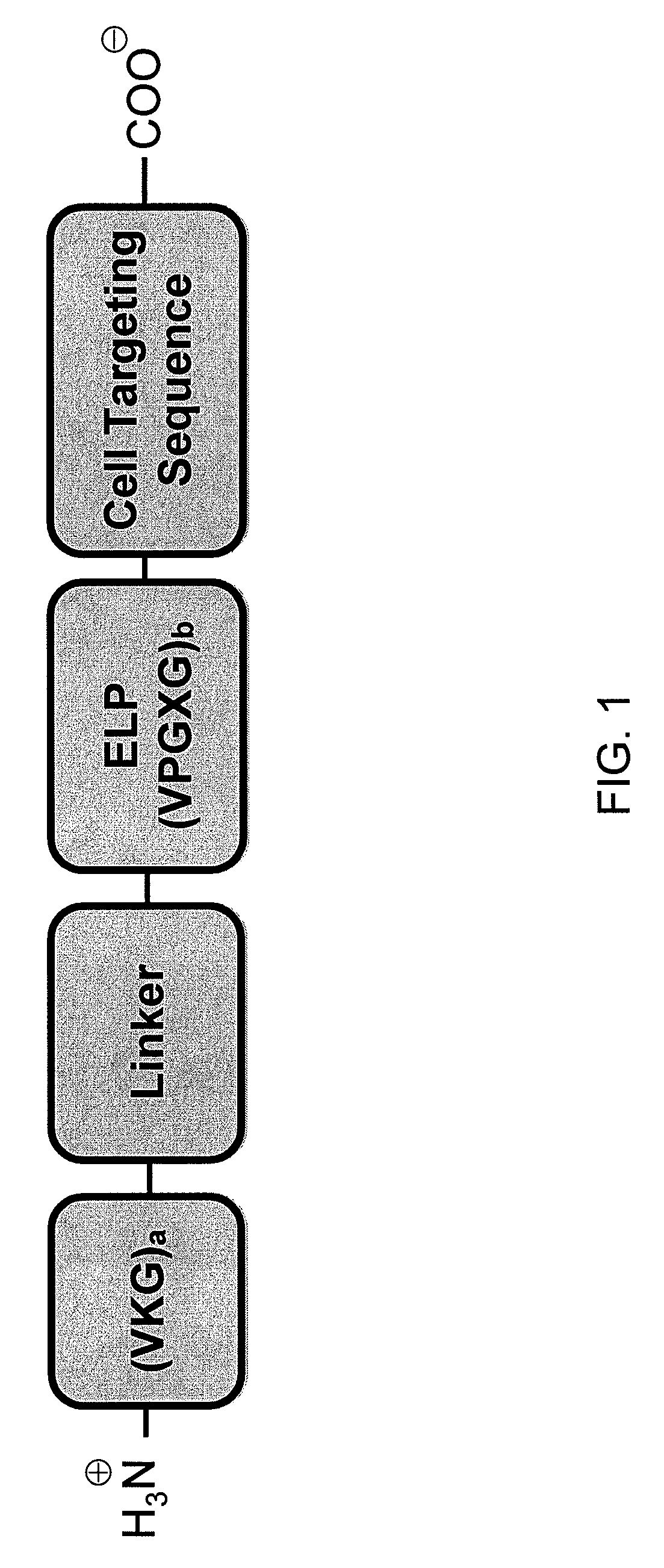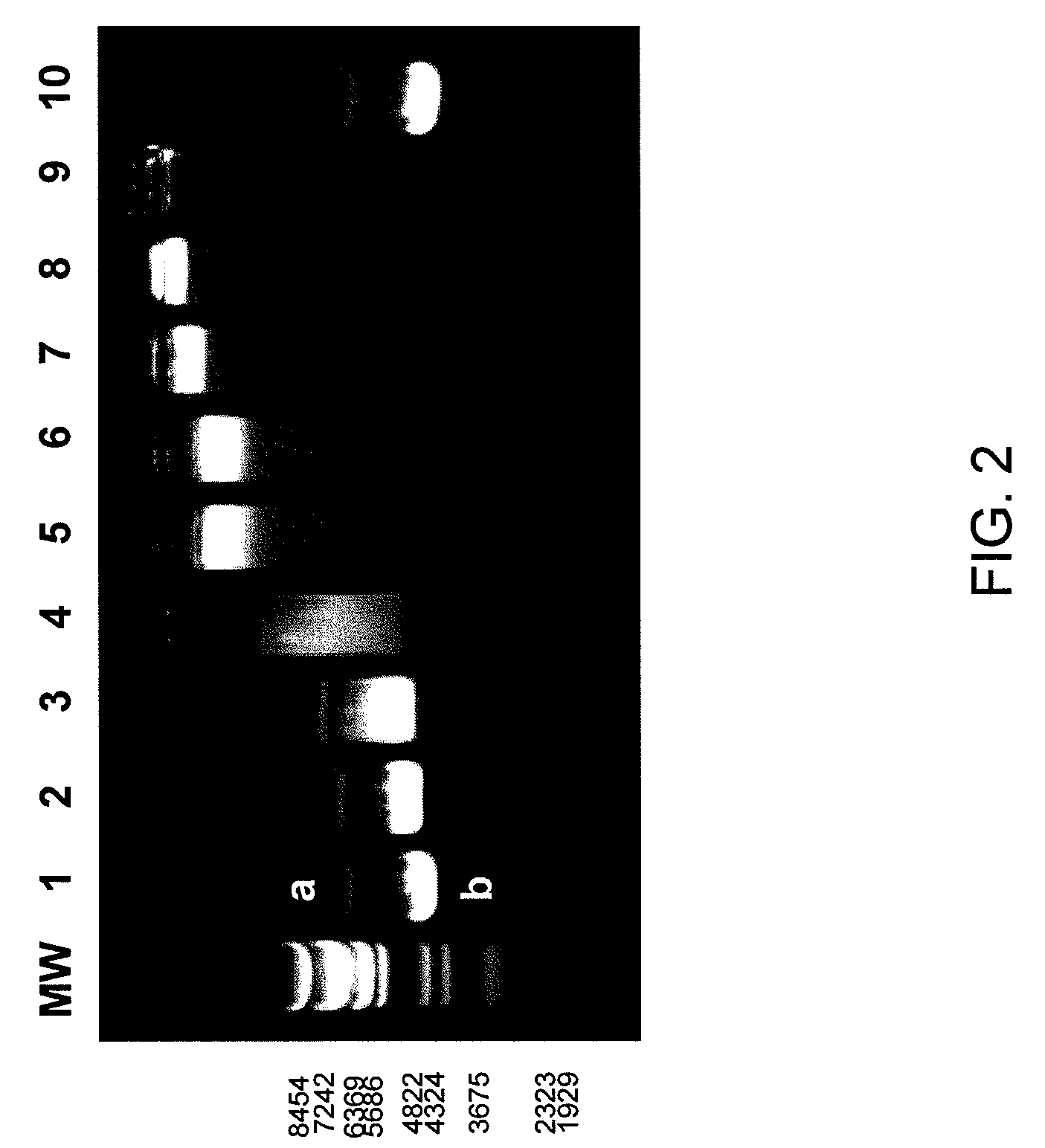Elastin-like polymer delivery vehicles
a polymer and elastin technology, applied in the field of medicine and molecular biology, can solve the problems of limited the ability of the therapeutic to diffuse to its site action and the rate of clearance, limit the use of many therapeutics, and suffer from the effects of polydispersity of synthetic polymers such as thes
- Summary
- Abstract
- Description
- Claims
- Application Information
AI Technical Summary
Benefits of technology
Problems solved by technology
Method used
Image
Examples
example 1
Construction of ELP Compositions
[0165]Construction of a nucleic acid binding domain. Initially, oligonucleotides are designed such that the EcoR I, HinD III, PflM I, and Bgl I restriction sites were conserved in the coding backbone to facilitate DNA oligomerization by seamless recursive directional ligation (SRDL). The initial (VKG)4 DNA sequences, forward and reverse respectively are as follows: 5′-aattcccacggcgtggttaaaggtgttaaaggtgttaaaggtgttaaagtgccgggcgggca-3′ (SEQ ID NO:2) and 5′-agcttgcccgcccggcactttaacacctttaacacctttaacacctttaaccacgccgtggg-3′ (SEQ ID NO:3). The oligonucleotides are annealed by heating an equimolar mixture of the two oligonucleotides at 95° C. for 5 min and then slowly cooling to room temperature to form a double-stranded DNA cassette with EcoR I and HinD III compatible ends. pUC19 is doubly digested with EcoR I and HinD III and enzymatically dephosphorylated using calf alykline phosphotase (CIP). The linearized pUC19 vector is purified from high-melt agarose ...
example 2
ELP Composition—Nucleic Acid Complexes
[0170]Various amounts of cationic (VKG)16ELP1-90 in PBS were mixed with 1 μg of hsp-EGFP plasmid DNA to obtain a desired N / P ratio ranging from 0.1 to 1.0. Total volume of reaction mixture was adjusted to 30 μl. After incubation on ice for 45 min, 15 μl of reaction mixture (equivalent to 500 ng of hsp-EGFP plasmid DNA) was analyzed by agarose gel electrophoresis.
[0171]DNA mobility retardation assay for the analysis of complex formation between (VKG)16ELP1-90 and hsp-EGFP plasmid. Electrophoresis was performed at 100 V for 60 min on a 1.0% high melting agarose gel and visualized by ethidium bromide staining (FIG. 2). Lane MW shows size standards with base pairs of 8454, 7242, 6369, 5686, 4822, 4324, 3675, 2323 and 1929. Lane 1 shows mobility of linear (a) and super-coiled (c) forms of hsp-EGFP plasmid in the absence of (VKG)16ELP1-90. Lane 2, 3, 4, 5, 6, 7, 8, and 9 represent the mixtures of (VKG)16ELP1-90 and hsp-EGFP plasmid at the N / P ratio of...
example 3
Thermal Transition Properties of ELP-Nucleic Acid Complexes
[0172]To characterize the inverse temperature transition of (VKG)4aELP copolymer and (VKG)4aELP / pDNA polyplexes, the optical density of sample solutions (typically 25, 12.5 or 6.25 μM of copolymer in PBS) is monitored at 350 nm as a function of temperature on a Cary 300 UV-visible spectrophotometer equipped with a multicell thermoelectric temperature controller (Cary Instruments, Walnut Creek, Calif.). The heating and cooling rates are 1° C. min−1. The derivative of the turbidity profile with respect to temperature is numerically calculated, and the Tt value is defined as the temperature at which the increase in turbidity is most rapid. Particale size is also determined by dynamic light scattering using a ZetaPlus, BI MAS Option (Brookhaven Instruments Corporation, Holtsville, N.Y.) (Table 5).
[0173]As the N / P ratio of decreases from 10 to 1, the Tt of polyplex decreases (FIGS. 3-5). At the N / P ratio of 1, the turbidity profi...
PUM
| Property | Measurement | Unit |
|---|---|---|
| thermal transition temperature | aaaaa | aaaaa |
| diameter | aaaaa | aaaaa |
| diameter | aaaaa | aaaaa |
Abstract
Description
Claims
Application Information
 Login to View More
Login to View More - R&D
- Intellectual Property
- Life Sciences
- Materials
- Tech Scout
- Unparalleled Data Quality
- Higher Quality Content
- 60% Fewer Hallucinations
Browse by: Latest US Patents, China's latest patents, Technical Efficacy Thesaurus, Application Domain, Technology Topic, Popular Technical Reports.
© 2025 PatSnap. All rights reserved.Legal|Privacy policy|Modern Slavery Act Transparency Statement|Sitemap|About US| Contact US: help@patsnap.com



